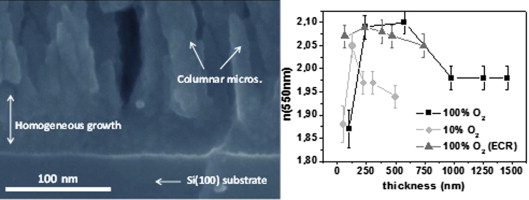A. Borrás, R. Alvarez, J.R. Sánchez-Valencia, J. Ferrer, A.R. González-Elipe
Microporous and Mesoporous Materials, 160 (2012) 1-9
doi: 10.1016/j.micromeso.2012.04.035

This work reports on the porosity and refraction index of TiO2 thin films as a function of the film thickness. Samples were fabricated by plasma enhanced chemical vapor deposition (PECVD) in a microwave electron cyclotron resonance (MW-ECR) reactor at room temperature using titanium tetra-isopropoxide (TTIP) as precursor. Experimental parameters such as plasma gas composition (pure oxygen and argon/oxygen mixtures) and pressure (either ECR conditions or “normal” pressure, i.e. 10−4 or 10−3 torrs correspondently) were varied. The evolution of the thin film microstructure, porosity and optical properties is critically studied by AFM, SEM, water adsorption isotherms, ellipsometry and UV–Vis transmittance and the existence of a certain critical thickness (tc) demonstrated. The porosity of the films with thicknesses ranging from several tens of nanometers up to half a micrometer is evaluated by QCM-isotherms at room temperature. The dependency of this critical thickness with the plasma conditions is evaluated experimental and theoretically. Thus, the microstructure change at tc is attributed to a transition from a surface diffused dominated growth mechanism for t < tc to another where shadowing is predominant. Dynamic scaling analysis of the two regimes and their Monte Carlo simulation complete the reported study.

